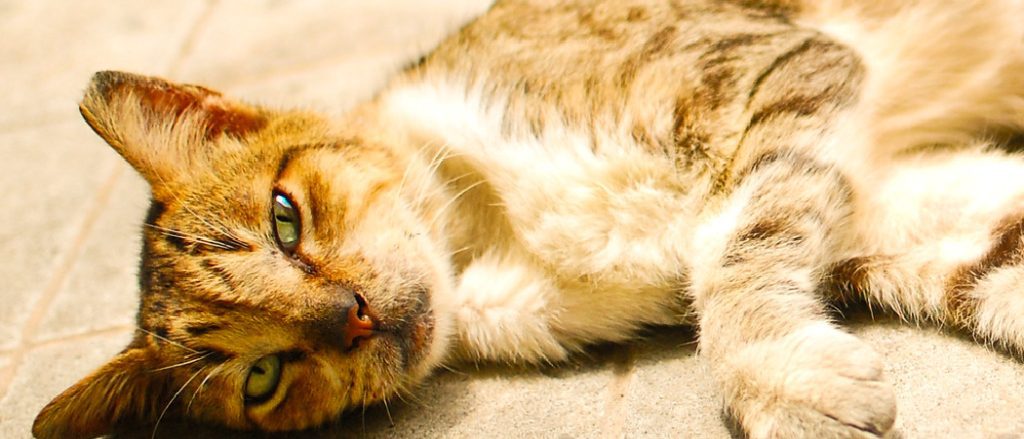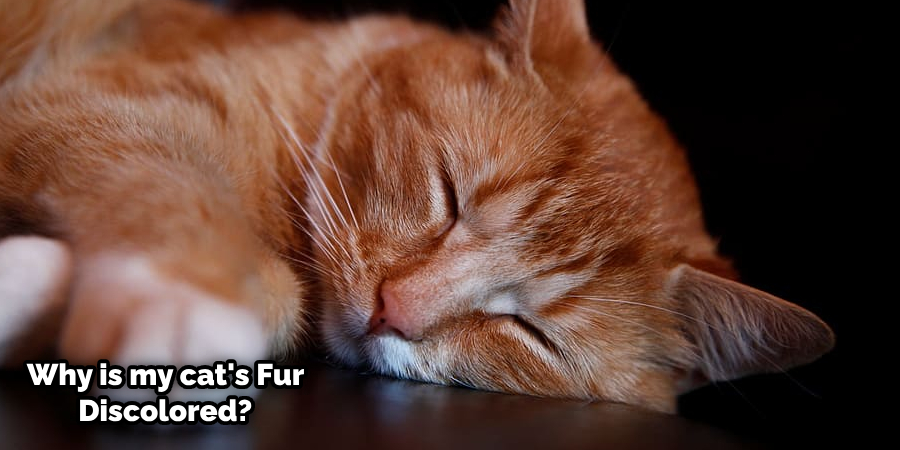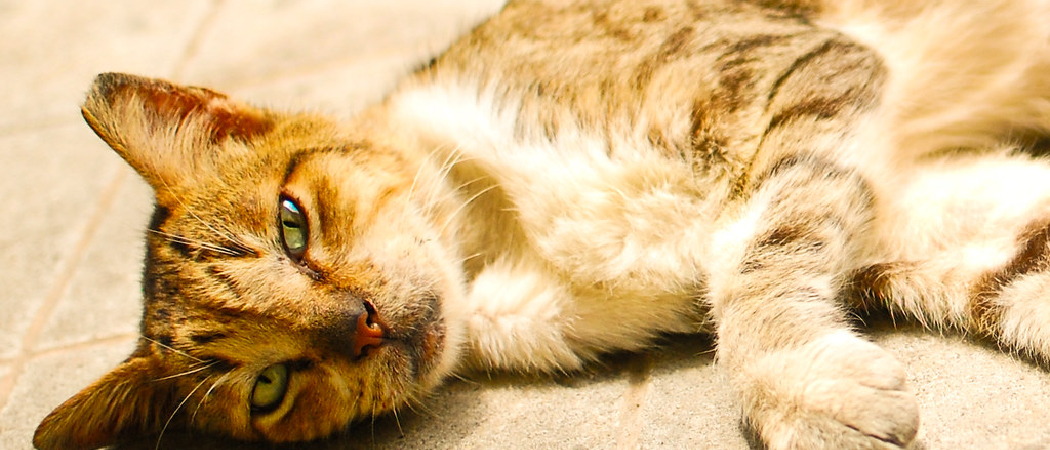You must use a pet-safe cleaner to remove a yellow stain from your cat’s fur. First, wet the area with warm water and then apply the cleaner. Work it into the fur and then rinse it off with warm water. Cats are cherished members of our families, providing us with endless love and companionship. However, even the most adored felines can occasionally leave us scratching our heads when it comes to certain grooming and hygiene issues. One common problem cat owners face is the presence of yellow stains on their cat’s fur. These unsightly stains can be caused by various factors, including urine, saliva, or even environmental pollutants. But fret not; in this comprehensive guide, we will explore the causes of these stains and provide you with effective solutions on how to remove yellow stains from your cat’s fur and restore its coat to its natural beauty.
Towel dry your cat’s fur and brush it out to help remove any remaining stains.

- Wet the stained area of the fur with warm water
- Apply a small amount of dish soap to the wet fur and rub it in gently
- Rinse the soapy fur with warm water until the suds are gone
- Repeat steps 2-3 if necessary
- Dry the fur with a towel and brush it out gently
If you want to know more about how to remove yellow stains from cat fur, keep reading!
Understanding the Causes of Yellow Stains
Before we delve into the solutions, it’s crucial to understand the reasons behind those yellow stains on your cat’s fur. This knowledge will help you not only remove the stains but also prevent them from recurring.
- Urine Stains:
- Cats may accidentally urinate on themselves or their fur due to health issues, such as urinary tract infections or bladder problems.
- Inappropriate urination can also result in urine stains on the fur, a behavior often associated with stress, territorial marking, or litter box aversion.
- Saliva Stains:
- Excessive grooming or drooling can lead to saliva stains on your cat’s fur.
- Cats with dental issues, allergies, or skin irritation may be more prone to excessive grooming and, consequently, saliva stains.
- Environmental Stains:
- Cats are curious creatures and may get into substances that stain their fur, such as pollen, mud, or certain types of grasses.
- Outdoor cats are more susceptible to environmental stains, but indoor cats are not entirely immune either.
Why is My Cat’S Fur Going Yellow?
If you’ve noticed that your cat’s fur is turning yellow, it’s important to take them to the vet as soon as possible. There are a few possible reasons why this could happen, and it’s important to get a diagnosis so you can treat your cat accordingly. One possibility is that your cat has jaundice, which is a condition caused by an excess of bilirubin in the blood.
Bilirubin is a yellow pigment that’s produced when red blood cells break down, and it can build up if there’s liver disease or other problems with the blood. Jaundice can make your cat’s whole body look yellow, not just their fur, and they may also have other symptoms like lethargy and loss of appetite. If your cat does have jaundice, it’ll need treatment from a veterinarian.
Another possibility is that your cat has developed allergies to something in their environment or food. Allergies can cause all sorts of skin problems, including itchiness, rashes, and bald spots. If you think allergies might be the problem, talk to your vet about doing some allergy testing.
In the meantime, you might need to make some changes to your cat’s diet or environment (like using hypoallergenic shampoo) to help them feel better. Finally, it’s also possible that your cat’s fur is simply discoloured from something they’ve been exposed to externally (like if they rolled around in the dirt or something). A good bath should do the trick!
But if you’re unsure of what might be causing the discoloration, always err on the side of caution and take them to the vet for an examination just to be safe.
How Do You Remove Yellow Stains from Cats?
There are a few ways that you can remove yellow stains from cats. One way is to use a mild detergent and warm water. Another way is to use white vinegar and water.
You can also try using baking soda and water. If the stain is fresh, you may be able to remove it with just soap and water.
Why is My Cats White Hair Turning Yellow?
There are a few reasons why your cat’s white hair may be turning yellow. It could be due to a lack of nutrients, such as vitamin A, in their diet. It could also be a sign of jaundice, which is a liver condition that can cause the skin and eyes to appear yellow.
If your cat shows other signs of illness, such as lethargy or appetite loss, you should take them to the vet for a check-up.
Why is my cat’s Fur Discolored?
If you notice that your cat’s fur is discolored, it could be due to a number of factors. First, consider what color the fur normally is. If the discoloration is drastic, it could indicate a health problem.
For example, if your black cat’s fur turns white, it could signify anemia or kidney disease. If your cat’s coat is usually a light color and it turns dark, it could be a sign of liver disease. There are also some non-health-related reasons why your cat’s fur might change color.
For example, if your cat spends time outdoors in the sun, its fur may lighten. Conversely, if your cat spends most of its time indoors, its fur may darken from lack of sunlight exposure. Age can also play a role in Fur discoloration; as cats get older, their coats may become lighter or darker due to changes in pigment production.

How to Remove Stains from White Cat Fur?
No one likes a dirty cat. And when your feline friend has white fur, those stains can be especially noticeable. But don’t despair – there are ways to get rid of them!
There are a few things you’ll need in order to remove stains from your cat’s fur: shampoo, hydrogen peroxide, and baking soda. Start by mixing together two parts of hydrogen peroxide with one part of water. Next, wet your cat’s fur and apply the mixture liberally.
Let it sit for a few minutes before rinsing thoroughly. If the stain is still visible, you can try using baking soda. Make a paste out of baking soda and water and apply it to the affected area.
Let it dry, and then brush it out. You may need to repeat this process a few times before the stain is completely gone. If all else fails, you can always take your cat to the groomer for a professional cleaning.
They will have the tools and products necessary to eliminate even the most stubborn stains!
Yellow Stain on Cat Fur
If you’ve ever had a yellow stain on your cat’s fur, you know how difficult it can be to remove. There are a few things you can do to remove the stain, but it’s important to act quickly. The longer the stain sits, the harder it will be to remove.
One way to remove a yellow stain from your cat’s fur is to use a mixture of vinegar and water. Simply mix equal parts vinegar and water in a bowl and apply it to the stained area with a cloth. Rub the mixture into the stain and then rinse with warm water.
You may need to repeat this process several times before the stain is completely gone. Another option is to use hydrogen peroxide. Again, mix equal parts of hydrogen peroxide and water in a bowl and apply them to the affected area with a cloth.
Rub gently and then rinse with warm water. You may need to repeat this process several times as well. If neither of these options works, you may need to try something stronger, like bleach or shampoo designed for pet stains.
Be sure to test any product on an inconspicuous area of your cat’s fur first before applying it directly to the stain. Follow the instructions on the product label carefully. No one likes dealing with stains, especially when they’re on our beloved pets.
But hopefully, one of these methods will help you eliminate that pesky yellow stain on your cat’s fur.
How to Remove Stain from Cat Fur?
If you have a cat, chances are you’ve had to deal with stained fur at some point. Whether it’s from dirt, grass, or food, stains can be tough to remove. But don’t worry – with a little elbow grease and the right products, you can get your cat’s fur looking good as new!
To start, brush your cat’s fur to loosen any dirt or debris that may be stuck in the stain. If the stain is fresh, you can try using a damp cloth to blot it out. Mix together vinegar and water in a bowl for tougher stains.
Dip a clean cloth into the mixture and dab it onto the stain. Let it sit for 5-10 minutes before rinsing off with warm water. You can also use this method on dry stains – just let the vinegar mixture sit on the stain for longer (30 minutes or more).
If the stain is still visible after trying these methods, you may need to resort to stronger cleaners. Pet stores sell special enzyme cleaners that are designed specifically for removing pet stains. Follow the instructions on the bottle and apply it directly to the stain.
Let it sit for 5-10 minutes before blotting it dry with a clean cloth. With a little patience and effort, you should be able to remove even the toughest stains from your cat’s fur!
Cat Leaving Yellow Spots on Bed
If you’re a cat owner, you know that sometimes your furry friend can be a little… quirky. One quirk that might have you scratching your head is if you find yellow spots on your bed. While it’s not the most common behavior, some cats will leave behind yellow spots on fabric as part of their marking territory.
There are a few things to keep in mind if you think your cat is leaving yellow spots on your bed. First, consider whether other objects in your home are marked with urine – like couches or rugs. If so, then it’s likely that your cat is just doing the same thing to mark their territory.
Second, look at the urine spot’s consistency – is it dry or wet? If it’s dry, then it’s probably an old spot that your cat has marked before and isn’t worth worrying about. However, if the spot is fresh and wet, then you’ll want to take action to clean it up and deter your cat from urinating in that area again.
Here are a few tips for cleaning up yellow spots left by cats: – Use an enzyme-based cleaner specifically designed for pet stains (available at most pet stores). This type of cleaner will break down the proteins in urine, making it easier to remove from fabrics.
– Soak the stained area in cold water for 10-15 minutes before applying the cleaner. This will help dilute the stain and make it easier to remove. – Apply the cleaner directly to the stain and scrub gently with a brush or cloth until it disappears.
Rinse thoroughly with cold water afterward.
Brown Stains on Cat Fur
Your cat’s fur may be brown for a variety of reasons. If your cat has recently been outdoors, he may have gotten dirty, and his fur may just need a good cleaning. However, if your cat’s fur is consistently brown, it could signify a more serious underlying condition.
Here are some potential causes of brown fur in cats: -Liver disease: One potential cause of liver disease is copper storage hepatopathy, which can lead to the accumulation of copper in the liver. This can eventually lead to brown discoloration of the fur.
-Kidney disease: Kidney disease can also lead to changes in fur color, as well as other symptoms like weight loss and increased thirst. -Nutritional deficiencies: A lack of certain nutrients in the diet can also cause changes in fur color. For example, a lack of biotin can lead to dry, brittle hair that is prone to breakage and discoloration.
Cats White Fur Turning Brown
If your cat’s white fur is turning brown, it could signify something serious. Here’s what you need to know about this change in your cat’s appearance. First, it’s important to note that a small amount of brown discoloration on your cat’s fur is normal and nothing to worry about.
However, if the brown patches are large or spread quickly, it could be a sign of a health problem. One possible cause of white fur turning brown is liver disease. The liver is responsible for filtering toxins out of the blood, and when it isn’t functioning properly, those toxins can build up in the body and cause changes in the fur.
If you notice that your cat’s white fur is turning brown, especially if they are also exhibiting other signs of liver disease (lethargy, appetite loss, weight loss), take them to the vet right away for treatment. Another possible cause of brown-tinged fur is anemia. Anemia occurs when there aren’t enough healthy red blood cells in the body to carry oxygen to all the tissues.
This lack of oxygen can cause changes in the color of the fur, as well as make your cat feel tired and weak. If you think your cat may be anemic, take them to the vet for testing and treatment.
White Fur Coat Turning Yellow Dog
If you’ve noticed that your dog’s white fur is turning yellow, there are a few possible explanations. First, it could be simply due to aging. As dogs age, their fur may lose its brightness and take on a more yellowish hue.
Secondly, diet can also play a role in your dog’s fur color. If your pet isn’t getting enough of certain nutrients, it can affect the quality and color of its fur. Finally, if your dog has been spending a lot of time in the sun, that could also be causing its white fur to turn yellow.
If you’re concerned about the change in color, it’s best to consult with your veterinarian to rule out any underlying health conditions and determine the best course of action.
How to Whiten Cat Fur?
If you have a white fur cat, you may wonder how to keep it looking its best. While some cats are born with naturally white fur, others may develop it as they age. Regardless of how your cat got its white fur, there are a few things you can do to help keep it looking bright and beautiful.
One of the best ways to whiten cat fur is to brush it regularly. This will help remove any dirt or debris that could be dulling the fur’s natural colour. You can use a soft bristle brush or even a damp cloth to gently brush your cat’s fur.
Just be sure not to brush too hard, as this could irritate your cat’s skin. In addition to brushing, you’ll also want to bathe your white-furred cat on a regular basis. Use a mild shampoo made specifically for cats, and avoid getting any water in their ears or eyes.
After bathing, be sure to thoroughly rinse all of the shampoos out of their fur. Again, avoid using too much force when towel drying them off – just pat them dry until they’re only slightly damp. After bathing and brushing, you may also want to use a special conditioner made for white-furred cats.
This can help restore shine and the body to its coat. Just apply the conditioner after shampooing, then rinse it out well before Towel drying them off as usual.
And there you have it!
Conclusion
Caring for your cat’s fur and maintaining their hygiene is an essential part of responsible pet ownership. While yellow stains on your cat’s fur can be frustrating, they are manageable with the right approach. By understanding the underlying causes, addressing health concerns, and following our step-by-step guide on how to remove yellow stains from cat fur, you can keep your feline friend looking and feeling their best.
Remember that patience and gentleness are key when dealing with grooming and stain removal, and always prioritize your cat’s comfort and well-being. With proper care and attention, you can keep your cat’s coat clean and beautiful, ensuring a happy and healthy life for your beloved pet.
Next, apply a pet-safe laundry detergent directly to the stain and rub it in using your fingers. Finally, rinse the area with warm water and blot it dry with a clean towel. If the stain persists, you may need to repeat these steps or consult a professional groomer. Thanks for reading our blog post about how to remove yellow stains from cat fur.


